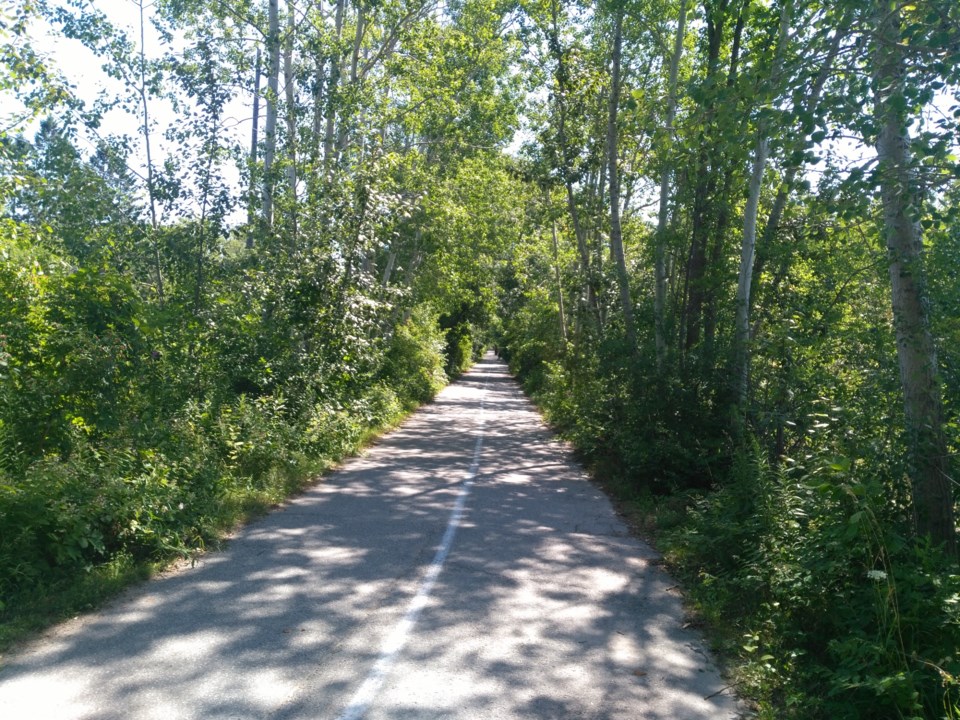EDITOR'S NOTE: OrilliaMatters is partnering with Sustainable Orillia to publish a weekly tip. Check back here every Tuesday evening for a new tip. For more information, visit the Sustainable Orillia website.
A recent Sustainable Orillia article on Orillia’s urban forest noted the efforts being made by Orillia’s Environmental Advisory Committee (EAC) and Councillor Tim Lauer to preserve and expand the tree canopy in our city. Recent scientific research indicates that doing so is more than a matter of maintaining the nice look of mature trees.
The article referred to the cooling aspect of a 40% canopy in a city. In addition, it may be no surprise to many to learn that having trees and other greenery nearby leads to feelings of happiness and contentment—much less anxiety in general.
But modern research is also uncovering significant correlations between tree cover in cities and the incidence of specific diseases. The research seems to indicate that the presence of trees in neighborhoods creates healthier people — findings that should lead city planners and residents to look closely at the degree of urban forests throughout urban areas.
Orillia’s older neighbourhoods, north of Coldwater Road/Street, appear to be the most heavily forested, largely because trees in those neighbourhoods are considerably more mature than in other parts of the city.
In contrast, newly developed areas of West Orillia lack tree cover, again largely because most of the trees in that area are newly planted. (Perhaps developers should be considering how to preserve mature trees when developing an area rather than clear-cutting everything and starting from zero?)
How big a factor in the health of people is the presence of significant tree cover? A look at vibrantcitieslab.com reveals significant connections between tree cover and specific diseases.
For example, a study quoted on the website notes that “In 15 [American] states infected with emerald ash borer, an additional 15,000 people died from cardiovascular disease and 6,000 more from lower respiratory disease compared with uninfected areas of the country.”
This relationship seems to be the result of the ability of trees to remove pollution from the air, the website noting that “pollution removed by trees in 2010 was modelled to have a combined human health value of $6.8 billion.”
Childhood asthma has also been a focus of study, especially as “U.S. childhood asthma rates increased by 50 percent from 1980-2000.” Again, trees were found to affect asthma rates in positive ways.
“Levels of asthma are highest where tree density is the lowest, but the rate of childhood asthma is 29% lower for every 343 trees per square kilometer.” Again, the ability of trees to remove pollutants from the air is likely the mechanism that leads to reduced asthma rates in children.
Not surprisingly, the presence of trees in neighbourhoods reduces the prevalence of skin cancer. The vibrantcitieslab.com website notes that “Urban trees reduce ultraviolet (UV) radiation, especially UV-B radiation, which is known to cause skin cancer. A person standing in direct sunlight takes 20 minutes to burn. Under a tree providing 50% coverage, it takes 50 minutes to burn. Under full shade it takes 100 minutes for one to get a sunburn.”
Perhaps more surprising is the idea that obesity can be reduced in neighbourhoods where trees abound.
Again, the vibrantcitieslab.com website notes that, “accounting for socioeconomic factors, residents of areas with highest levels of greenery were three times as likely to be physically active and 40% less likely to be overweight or obese than residents living in the least green settings.”
Perhaps the connection is not so very surprising when one considers how much more pleasant it is to be outside among greenery compared to being outside in surroundings consisting of asphalt and concrete.
Areas with plentiful trees and lots of other greenery are clearly more inviting to people to get outside and be active—gardening, walking, cycling—and physical activities like this could account for the healthier weight in people living in such areas.
What more can treed areas do for people that live among them? How about helping us live longer? A 2017 CBC article by Connie Chung summarizes research that suggests this to be true.
Researchers at the University of New Brunswick used census and tax data to track 1.3 million non-immigrant Canadian adults living in the 30 biggest cities across the country, from Victoria to St. John's, over 11 years starting in 2001.
They measured the amount of greenery from trees, shrubs, grass and other plants within 250 metres (about two blocks) of the study subjects' homes, using postal codes and satellite data. And they found that as the amount of greenery increased, people's risk of premature death decreased "significantly" from natural causes.
Dan Crouse, the study’s lead author, was surprised by the results.
"There was a lot bigger effect than I think any of us had been expecting," said Crouse, a health geographer, of the study published in the journal, The Lancet Planetary Health. "What we're able to show with this study is just having trees around where people are living is really important," Crouse said.
Cardiovascular disease, asthma, skin cancer, obesity and even incidences of premature death—all reduced simply by living among trees. These studies are not just scientific curiosities.
They should be indication to planners in cities — both large and small — of the importance of creating and maintaining mature tree canopies in all living areas.
Individual property owners can do much themselves to ensure trees are part of their environment, but with the proper focus on ensuring that trees are a significant part of city planning and development, community leaders can ensure healthier populations. Surely that’s a significant responsibility of municipal and city governments everywhere.
